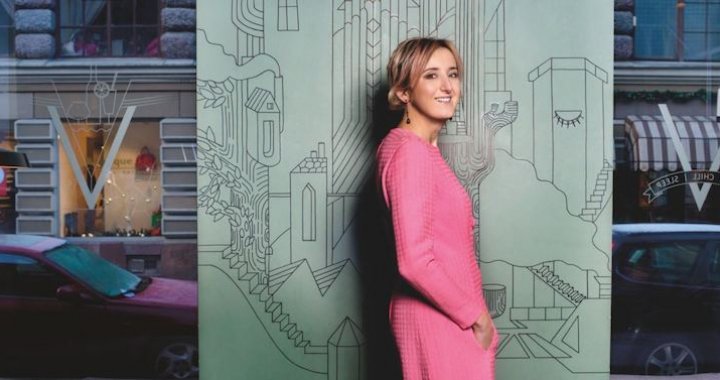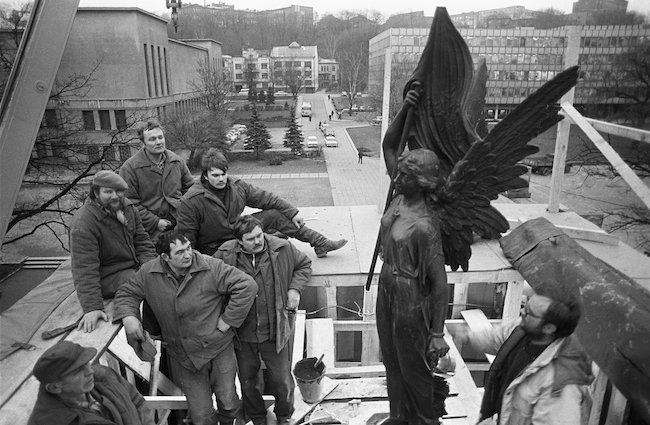
11th Kaunas Biennial “There And Not There: (Im)possibility of a monument”
Q&A with Paulina Pukytė, curator of the 11th Kaunas Biennial
28/07/2017
11th Kaunas Biennial “There And Not There: (Im)possibility of a monument”
Kaunas, Lithuania
September 15 – November 11, 2017
The 11th Kaunas Biennial “There And Not There”* will open on 15 September 2017 and will question the notion of monument: what, when and why should a monument be or not be. While opposing the populist practice of removing-erecting and conservative traditionalism, both of which are prevalent in the memory discourse of public art in Lithuania, the Biennial will stimulate and legitimise new, contemporary, conceptual, and relevant ideas and strategies of remembrance. The exhibition will take place in public spaces of the city.
The 11th Biennial’s curator, artist Paulina Pukytė**, has invited artists from Lithuania, Germany, Slovenia, Great Britain, Japan, the Netherlands, South Africa, and Poland to make site-specific installations for Kaunas.

Romualdas Požerskis. This photo reveals the restoration of Freedom monument in Kaunas / Lithuania on 10 February 1989 – a half year before Berlin Wall was opened and almost a year before it was destroyed
While the Biennial was still in its preparatory stages, posed three substantial questions to Pukytė concerning the choice of theme for the Biennial, as well as what are the hopes for the mega-exhibition’s resultant, real-life influence on the issues that it will raise.
The 11th Kaunas Biennial There And Not There will question the notion of monument: what, when and why should a monument be or not be. What served as an inspiration for this choice of theme for the Biennial?
In recent years the question of monuments has become hot in Lithuania again – two very controversial new monument competitions, and the rows around them, seem never-ending, and, in the meantime, the last remaining specimens of Social realism (“Soviet sculptural heritage”) were removed form the public space in Vilnius, causing a lot of debate and controversy, too.
When Lithuania broke free from the rule of the Soviet Union a quarter of a century ago, it quickly got rid of all the monuments and sculptures that had anything to do with communist ideology or the Soviet occupation. Then, with the same hastiness, we rebuilt most of the national monuments that the Soviets had destroyed, and erected some new ones – in the same pre-WWII style as well as in terms of content. After paying that debt to the past, we could hope for new public art to become more contemporary. However, apart from a few exceptions, that didn’t happen. In fact, we are experiencing regression – on a certain level, there is a rising urge to erect more and more bronze heroes (some on horses) that the new generation cannot relate to.
The 11th Kaunas Biennial seeks to oppose this populist practice of removing-erecting, as well as that of conservative traditionalism, both of which are prevalent in the memory discourse of public art in Lithuania; we wish to stimulate and legitimise new, contemporary, conceptual, and relevant ideas and strategies for commemoration.
Taking into account the idea that people today rely on the cultural sector more than they do on politicians, what do you think about the curator’s responsibility in terms of an event like this Biennial? To what extent should the Biennial distance itself from – or the reverse, involve itself with – reality?
Art is not reality, and it should remain so. However, it cannot exist in a vacuum, unconnected to reality. My idea for this Biennial is to get involved with reality, i.e. with important local issues, but to do it by purely artistic means. As a curator, I want to eschew the didacticism, rigidity and demagogy of monument forms and strategies –by taking the decision-making away from political manipulators, money-bags, functionaries, and the general public, and instead, handing it to the artists.
What sort of an effect do you expect this project could have on the society of Kaunas (and Lithuania in general)? Would there be any lasting repercussions?
All the artwork in the 11th Kaunas Biennial will be site-specific interventions in public spaces. My intention is to make the artwork accessible not only to the Biennial-goers and art lovers, but also to the general public that normally does not go to art exhibitions. Some of them will not only encounter the work but will interact with it, often without even being aware of it being art. I believe that only this kind of unplanned interaction is a real interaction. If the artwork touches even a few people, especially those who are “not interested in art”, I think it will already be a lasting repercussion. And perhaps the different strategies of commemoration, as suggested by the artists, could make even a small contribution to broadening the minds of the general public, as well as some decision makers, by taking them at least one small step away from their conservative and often primitive understanding of what the purpose of monuments is.
*Participating artists of “There And Not There: (Im)possibility of a monument”: Adina, Manca Bajec, Karolina Freino, Allard van Hoorn, Jenny Kagan, Horst Hoheisel & Andreas Knitz, Jonas Oškinis & Raimundas Krukonis, Juozas Laivys, Dainius Liškevičius, Anton Lukoszevieze, Philip Miller, Tatzu Nishi, Paulina Pukytė, Juozas Zikaras. Special guest: Sophie Calle
**Paulina Pukytė (b. 1966, Vilnius) is an artist, writer, essayist, and curator of the 11th Kaunas Biennial. She writes critical and satirical articles on culture, and has published a collection of essays, as well as two fiction books. Her interdisciplinary artistic practice includes site-specific interventions, moving image, text, and found artefacts – twisting meanings, questioning accustomed truths and our perception, deconstructing socio-ideological myths and socio-cultural clichés. Often both poetic and humorous, her art strategies are consciously restrained, almost invisible, and she embraces serendipity. Paulina Pukytė acts as a mediator between art and life, an interpreter and transmitter of cultural experience, rehabilitating what is seemingly unimportant and “inferior”, but terribly human.